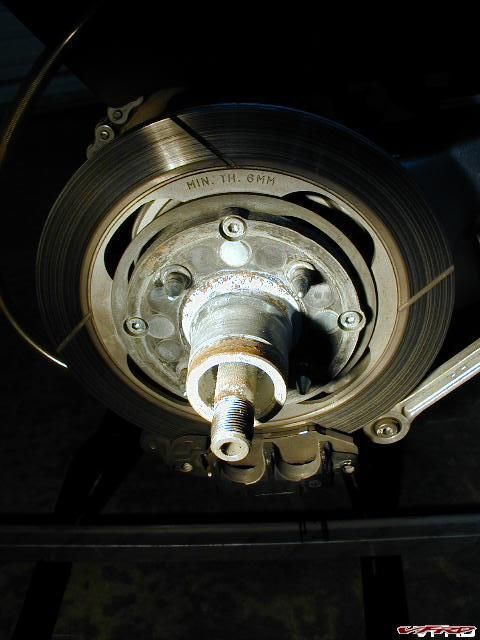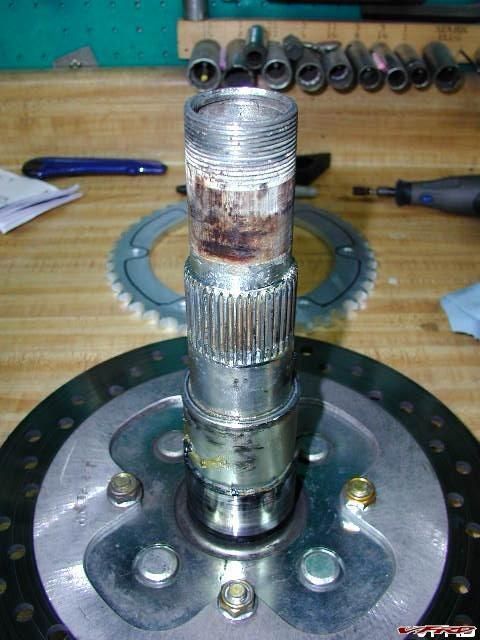- Home
- Forums
- Motorcycles, Boating, Small Engine, Aviation, Powe
- Motorcycles and Motorcycle Lubrication
You are using an out of date browser. It may not display this or other websites correctly.
You should upgrade or use an alternative browser.
You should upgrade or use an alternative browser.
S100 Total Cycle Cleaner
- Thread starter zrxkawboy
- Start date
It's readily available on Amazon.
I believe Hondabrite is the same thing as S100 total cycle cleaner. Not 'similar' but the exact same thing rebadged.
- Joined
- Mar 20, 2025
- Messages
- 81
I haven't tried the S100, but I use the Muc-Off brand. I bought a 1-liter bottle of it for 20 bucks on Amazon. You can then buy the concentrate for 90 bucks, which makes 20 1-liter bottles. For my CBR 600RR, I average about 4-6 washes per 1-liter bottle, so it works out to about a dollar per wash.
I will say it works well, but here is how I clean my bike:
products:
https://us.muc-off.com/collections/...h-motorcycle-cleaner-1l-5l-concentrate-refill
https://www.chemicalguys.com/products/gerbil-wheel-and-rim-brush
https://www.amsoil.com/p/amsoil-microfiber-detail-towel-2-pack-g3912/
https://www.amsoil.com/p/amsoil-drying-towel-g3913/
I will say it works well, but here is how I clean my bike:
- Hook up the garden hose and wet the bike down. Let it soak to loosen up the bugs and dirt.
- Spray it down with the jet setting nozzle (no pressure washer). This gets 99 percent of the bugs and dirt off.
- Squirt the Muc-Off on every inch of the bike.
- Use a wash mitt or detailing rag to work in the Muc-Off, making sure to get every bug and last morsel of dirt.
- Grab a wool wheel gerbil and clean the rims.
- Hose down the bike thoroughly. You don't want any of the Muc-Off still on the bike.
- Grab the leaf blower and blow most of the water off and out of the radiator.
- Use a big drying towel to dry it off.
products:
https://us.muc-off.com/collections/...h-motorcycle-cleaner-1l-5l-concentrate-refill
https://www.chemicalguys.com/products/gerbil-wheel-and-rim-brush
https://www.amsoil.com/p/amsoil-microfiber-detail-towel-2-pack-g3912/
https://www.amsoil.com/p/amsoil-drying-towel-g3913/
Busy Little Shop's 3 step method of bike cleaning without a garden hose...
1) At the end of the day soak a wash cloth in very HOT water and remove bugs
and road grime... repeat as necessary...
2) Add plastic polish to fairings and gas tank and buff to a shine...
3) Add a little Gasoline to the corner of the rag and degrease
wheels and chain... plastic polish wheels to add a nice luster...
Hitting your bike with a garden hose may be bike abuse because it promotes
corrosion in all the little nooks and crannies... why just look at Pat's RC30 axle
after repeated sprays with the garden hose... its pitiful as the metal is etched for life...

If your VFR axle looks like this then it is suffering the effects of
corrosion... mainly due to riding in the rain or hitting your prize
with a garden hose... both acts promote corrosion in all the little
nooks and crannies... you might wish to pull the axle and check
the sprocket side as well... the cush drive is another moisture trap...


After 19 years and 58K miles of perverted highway I've never once hit
my RC45 with a garden hose...

1) At the end of the day soak a wash cloth in very HOT water and remove bugs
and road grime... repeat as necessary...
2) Add plastic polish to fairings and gas tank and buff to a shine...
3) Add a little Gasoline to the corner of the rag and degrease
wheels and chain... plastic polish wheels to add a nice luster...
Hitting your bike with a garden hose may be bike abuse because it promotes
corrosion in all the little nooks and crannies... why just look at Pat's RC30 axle
after repeated sprays with the garden hose... its pitiful as the metal is etched for life...

If your VFR axle looks like this then it is suffering the effects of
corrosion... mainly due to riding in the rain or hitting your prize
with a garden hose... both acts promote corrosion in all the little
nooks and crannies... you might wish to pull the axle and check
the sprocket side as well... the cush drive is another moisture trap...


After 19 years and 58K miles of perverted highway I've never once hit
my RC45 with a garden hose...
Last edited:
- Joined
- Mar 20, 2025
- Messages
- 81
I agree. Most cleaning can be done with a hot water rag. What kind of tires do run on that thing @BusyLittleShop?Busy Little Shop's 3 step method of bike cleaning without a garden hose...
1) At the end of the day soak a wash cloth in very HOT water and remove bugs
and road grime... repeat as necessary...
2) Add plastic polish to fairings and gas tank and buff to a shine...
3) Add a little Gasoline to the corner of the rag and degrease
wheels and chain... plastic polish wheels to add a nice luster...
Hitting your bike with a garden hose may be bike abuse because it promotes
corrosion in all the little nooks and crannies... why just look at Pat's RC30 axle
after repeated sprays with the garden hose... its pitiful as the metal is etched for life...

If your VFR axle looks like this then it is suffering the effects of
corrosion... mainly due to riding in the rain or hitting your prize
with a garden hose... both acts promote corrosion in all the little
nooks and crannies... you might wish to pull the axle and check
the sprocket side as well... the cush drive is another moisture trap...


After 19 years and 58K miles of perverted highway I've never once hit
my RC45 with a garden hose...

I find ONR (Optimum No Rinse) works very well and removes bug guts quite well. And if you have chrome pieces, it’s simply amazing on these.
The only thing it struggles with is greasy or oily stains, but those are rare on well maintained motorcycles.
The only thing it struggles with is greasy or oily stains, but those are rare on well maintained motorcycles.
I agree. Most cleaning can be done with a hot water rag. What kind of tires do run on that thing @BusyLittleShop?
That thing is a rare and exotic homolgated racer and the best tire to run is the Pirelli Supercorsa SP...
expensive but you can't ask for more at Go-straight-to-Jail-Speeds...
- Joined
- Mar 20, 2025
- Messages
- 81
That's what I've started running—the Pirelli Supercorsa SP V4. On a hot day, it's almost impossible to break traction on those things.That thing is a rare and exotic homolgated racer and the best tire to run is the Pirelli Supercorsa SP...
expensive but you can't ask for more at Go-straight-to-Jail-Speeds...
View attachment 287657
That's what I've started running—the Pirelli Supercorsa SP V4. On a hot day, it's almost impossible to break traction on those things.
All reeeeet... It's like I have a V4 brother... SP stands for Sport Production... your Ducati was designed with this tire in mind...
Have you visited the factory in Italy???
Ducati Apollo V4 1964...
2004 Ducati MotoGp V4...
Last edited:
Installation error. There should have been a thin layer of grease applied to prevent corrosion, and the two parts seizing together.
BLS, is that a customer of your's bike?
When I was a teenager in 1983, I knew to put a thin coating of grease on the axle before putting it back in, and that was on a $100 used Honda Express moped.
When I was a teenager in 1983, I knew to put a thin coating of grease on the axle before putting it back in, and that was on a $100 used Honda Express moped.
There are a lot of people that strictly follow what manufacturers do and motorcycles coming out of factories are all dry, I suspect they follow what the OEMs are doing.BLS, is that a customer of your's bike?
When I was a teenager in 1983, I knew to put a thin coating of grease on the axle before putting it back in, and that was on a $100 used Honda Express moped.
There are a lot of people that strictly follow what manufacturers do and motorcycles coming out of factories are all dry, I suspect they follow what the OEMs are doing.
Don't disagree on that. My point being, as a kid I was already aware of the issue we are talking about and a very thin coat of grease on the axle prevents it with no downside. It also makes it easier to get the axle out the next time by avoiding said corrosion. Manufacturers will save every bit of oil or grease they can, across hundreds of thousands of bikes it adds to the bottom line. Because manufactures do it doesn't mean it's the best way for longevity and protecting parts in a case like an axle.
There are a lot of people that strictly follow what manufacturers do and motorcycles coming out of factories are all dry, I suspect they follow what the OEMs are doing.
In the factory service manual for the CBR1100XX I used to own, it states to apply a thin coat of grease to the axle(s). Now that's not a VFR, but it is a Honda.
The same recommendation is in every service manual for other brands I own.
Oh I do the same, but I've had many used bikes and most didn't have any grease on the axles at all and were hard to remove and they must've been serviced at some point because many of them were 20-30 years old.Don't disagree on that. My point being, as a kid I was already aware of the issue we are talking about and a very thin coat of grease on the axle prevents it with no downside. It also makes it easier to get the axle out the next time by avoiding said corrosion. Manufacturers will save every bit of oil or grease they can, across hundreds of thousands of bikes it adds to the bottom line. Because manufactures do it doesn't mean it's the best way for longevity and protecting parts in a case like an axle.
I agree, for the traditional axles all the service manuals that I dealt with also called for a thin coat of grease. But a single sided swing are is more like a car wheel hub, so it may not call for anything.In the factory service manual for the CBR1100XX I used to own, it states to apply a thin coat of grease to the axle(s). Now that's not a VFR, but it is a Honda.
The same recommendation is in every service manual for other brands I own.
But regardless if the service manual calls for it or not, one has to use some common sense. If the part is visibly corroded and difficult to remove, a thin coat of grease will solve this issue and should be applied in such cases, even if the documentation doesn't call for it.
Similar threads
- Replies
- 30
- Views
- 2K
- Replies
- 4
- Views
- 760
- Replies
- 59
- Views
- 1K
- Replies
- 11
- Views
- 376
- Replies
- 41
- Views
- 2K
